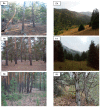Factors Limiting Radial Growth of Conifers on Their Semiarid Borders across Kazakhstan
- PMID: 37106804
- PMCID: PMC10135724
- DOI: 10.3390/biology12040604
Factors Limiting Radial Growth of Conifers on Their Semiarid Borders across Kazakhstan
Abstract
The forests of Central Asia are biodiversity hotspots at risk from rapid climate change, but they are understudied in terms of the climate-growth relationships of trees. This classical dendroclimatic case study was performed for six conifer forest stands near their semiarid boundaries across Kazakhstan: (1-3) Pinus sylvestris L., temperate forest steppes; (4-5) Picea schrenkiana Fisch. & C.A. Mey, foothills, the Western Tien Shan, southeast; (6) Juniperus seravschanica Kom., montane zone, the Western Tien Shan, southern subtropics. Due to large distances, correlations between local tree-ring width (TRW) chronologies are significant only within species (pine, 0.19-0.50; spruce, 0.55). The most stable climatic response is negative correlations of TRW with maximum temperatures of the previous (from -0.37 to -0.50) and current (from -0.17 to -0.44) growing season. The strength of the positive response to annual precipitation (0.10-0.48) and Standardized Precipitation Evapotranspiration Index (0.15-0.49) depends on local aridity. The timeframe of climatic responses shifts to earlier months north-to-south. For years with maximum and minimum TRW, differences in seasonal maximal temperatures (by ~1-3 °C) and precipitation (by ~12-83%) were also found. Heat stress being the primary factor limiting conifer growth across Kazakhstan, we suggest experiments there on heat protection measures in plantations and for urban trees, alongside broadening the coverage of the dendroclimatic net with accents on the impact of habitat conditions and climate-induced long-term growth dynamics.
Keywords: Kazakhstan; climate–growth relationship; conifers; lower forest boundary; tree-ring width.
Conflict of interest statement
The authors declare no conflict of interest. The funders had no role in the design of this study; in the collection, analyses, or interpretation of data; in the writing of the manuscript; or in the decision to publish the results.
Figures







References
-
- Breshears D.D., Whicker J.J., Johansen M.P., Pinder J.E. Wind and water erosion and transport in semi-arid shrubland, grassland and forest ecosystems: Quantifying dominance of horizontal wind-driven transport. Earth Surf. Process. Landf. 2003;28:1189–1209. doi: 10.1002/esp.1034. - DOI
-
- FAO . The State of the World’s Forests 2018—Forest Pathways to Sustainable Development. Food and Agriculture Organization; Rome, Italy: 2018.
-
- Jhariya M.K., Banerjee A., Meena R.S., Yadav D.K. Sustainable Agriculture, Forest and Environmental Management. Springer; Singapore: 2019. - DOI
-
- Verkerk P.J., Costanza R., Hetemäki L., Kubiszewski I., Leskinen P., Nabuurs G.J., Potocnik J., Palahi M. Climate-smart forestry: The missing link. For. Policy Econ. 2020;115:102164. doi: 10.1016/j.forpol.2020.102164. - DOI
-
- Carrer M., Urbinati C. Age-dependent tree-ring growth responses to climate in Larix decidua and Pinus cembra. Ecology. 2004;85:730–740. doi: 10.1890/02-0478. - DOI
Grants and funding
LinkOut - more resources
Full Text Sources

